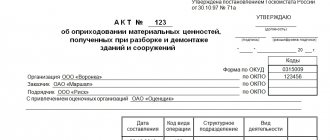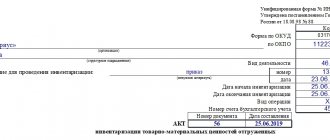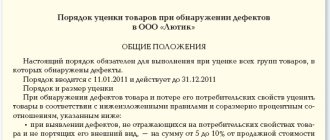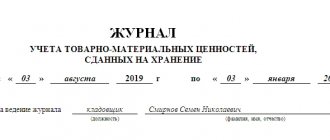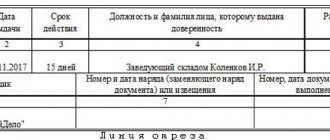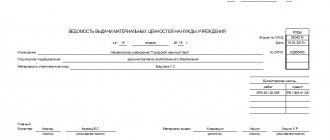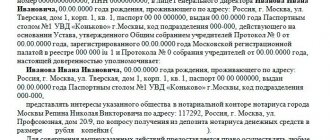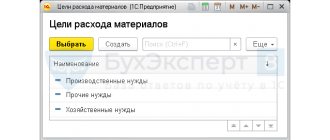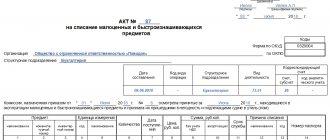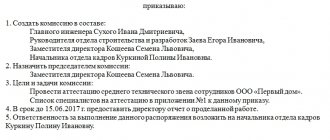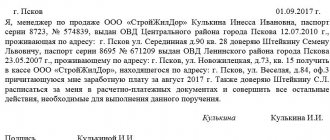Basic rules for filling out form M-4
Since 2013, this form has not been strictly mandatory for use, however, it is still widely used in enterprises and organizations.
The receipt order has two sides and contains all the necessary information regarding the supplier, consumer and the product itself: its name, grade, size, quantity, cost, etc. (it should be noted that some cells can be left empty). If the inventory contains precious metals or stones, then this document must indicate information from the accompanying technical passport.
When filling out an order, you should avoid mistakes and omissions, and if there are any inaccuracies, it is better to fill out a new form.
According to the rules, the form can be filled out either by hand or on a computer, but in any case, the document must necessarily contain “live” signatures of the supplier’s representative and the consumer.
After registration, the number of the receipt order must be registered in the materials accounting card and transferred for storage to the accounting department of the enterprise, where it, like other primary documents, must be stored for at least five years.
The document is issued exactly on the day the goods are received and reflects the actual receipt. A receipt order is drawn up in one copy, and if there are several deliveries from the same supplier within one day, they can all be entered into one document.
Stamp instead of a receipt order
In some cases, instead of a receipt order, the storekeeper may use a stamp. This can be done if goods arrive at the warehouse based on an invoice, act, or sales receipt. A sample stamp instead of an M-4 receipt order will contain the following fields to fill out: date, receipt order number, company name, data of the receiving party. The stamp in this case will contain the same details as in the M-4 receipt order. There is no point in adding details to the stamp that will reflect the quantity of goods received. It is worth keeping in mind that you can put a stamp on an incoming document if the document does not contain corrections and the quantity of goods received corresponds to what is indicated in the documents.
If, upon receiving inventory items, a warehouse employee understands that the declared quantity of goods differs from the quantity that actually arrived at the warehouse, or the quality of the goods does not meet the requirements for them (for example, the goods arrived with damage, scratches, dents, etc. .), then an act of acceptance of materials should be issued. For example, in this case, you can use the unified form No. M-7.
Instructions for filling out a receipt order
It is impossible to say that this type of document may cause any difficulties when filling out, since it has a completely simple and understandable form. The standard receipt order form can be divided into several parts, which contain three tables.
Filling out the “header” and first table of form M-4
The first table is the “header” of the document. First, it indicates the order number for the company’s internal document flow. Then enter the name of the organization receiving the goods, indicating its legal form (IP, LLC, OJSC, CJSC), the OKPO code (All-Russian Classifier of Enterprises named after Organizations - the code is contained in the constituent papers of the company), as well as (if necessary) the structural unit , which issues the order.
Next, the table includes the date the document was compiled, the transaction type code (if such coding is used), the supplier’s warehouse number, its full name, code (if any) and the insurer (if the inventory items are insured). Then the accounting account numbers, analytical accounting code (if such a system is used), and the numbers of the accompanying and payment documents are indicated here.
Filling out the second table of form M-4
The second table of the receipt order relates directly to incoming products . First, the name of the product and its item number are indicated, then the unit of measurement: its code - in accordance with the Unified Classifier of Units of Measurement, and the name (pieces, kilograms, cubes, meters, etc.). Next, information is entered on the number of accepted inventory items (according to documents and actually) - they must match.
After this comes information about the cost: in the seventh column the price per piece is entered, then the total cost excluding VAT, then the allocated VAT, and then the total price including VAT. The passport number is indicated if inventory items have this accompanying document (for example, jewelry). Lastly, the card number according to the warehouse card index is entered into the table.
The remaining unfilled lines must be crossed out (in the form of the letter Z or crosswise).
Filling out the reverse side of the M-4 form
The reverse side of the document summarizes the receipt : the total quantity of goods received, its total cost excluding VAT, the amount of VAT and the cost including VAT. There is no need to decipher the amounts in writing.
Finally, the receipt order must be signed by the direct recipient of the goods (in this case, the storekeeper) and the supplier’s representative (in this case, the forwarder) with a mandatory decoding. There is no need to certify the order with a seal, because Since 2016, legal entities may not have their documents stamped.
How to issue a receipt order
The finished receipt order form is presented by Goskomstat Resolution No. 71a dated October 30, 1997 in form M-4. It is issued separately for each delivery of material assets on the day of their acceptance. If several deliveries of the same type of materials from one supplier were accepted on one day, then it is permitted to issue a single order for all deliveries. To do this, information for each delivery is first recorded on the free (back) part of the document. And at the end of the day they are counted and, in a summarized form, transferred to the tabular part of the receipt order.
You can develop your own form of order, but in compliance with the requirements of the Law “On Accounting” dated December 6, 2011 No. 402-FZ. It is recommended to create your own form of the primary document in cases where additional details and fields are required. If there is no such need, then it is better to use the standard form.
There is also a third option for registering a receipt order, proposed by order of the Ministry of Finance of the Russian Federation dated December 28, 2001 No. 119n - in the form of affixing a stamp on a document received from the supplier (on an invoice, invoice, waybill, etc.). This method is the most convenient and allows you to reduce time and office expenses.
The order stamp is placed either in a free space on the front side of the invoice (invoices, TTN, etc.) or on its reverse side. Exactly what details should be present in the stamp are shown in the figure below:
Filling out a unified order M-4
As we have already said, in a situation where materials received under one receipt document need to be distributed to different warehouses or to different financially responsible persons, there is a need to use the receipt order M-4.
The receipt order is signed by two financially responsible persons:
- from the receiving party - the organization's storekeeper. By signing the receipt order, he confirms that he has assumed financial responsibility for the goods and materials received at the warehouse on a certain date;
- from the transferring party - the employee who delivered the goods to the organization. This can be an employee of either a third-party organization, say, a supplier (driver, delivery manager), or one of your own (driver, purchasing manager, workshop manager). By signing the receipt order, he confirms that he transferred the materials to the warehouse on a certain date.
If materials are delivered to the warehouse according to different receipt documents, but from the same supplier are delivered by one materially responsible person, then it is permissible for all materials to be received according to one receipt order in the unified form M-4para. 3 clause 49 of Directive No. 119n.
Fill out your own receipt order form
You can develop your own form of receipt order based on the unified form No. M-4 if there is a need to register receipt on the same day from different suppliers of goods and materials delivered to the warehouse by one financially responsible person.
The use of such a “consolidated” order is permissible if two conditions are met:
- The form of the primary accounting document must be approved by the head of the organization. 4 tbsp. 9 of Law No. 402-FZ;
- the primary document must contain all the required details (the name of the organization that compiled it, the number and date of the document, the contents of the transaction, the unit of measurement, as well as the positions, surnames, initials and signatures of the persons who performed the transaction), etc. 2 tbsp. 9 of Law No. 402-FZ.
Let's see how this can be done. Let’s say right away that unused columns from the unified receipt order of the M-4 form can be excluded to simplify the form. Or add the necessary columns to the order.
OPTION 1. We insert additional rows into the information table of the M-4 receipt order so that several suppliers can be specified. Data on all inventories are entered into the main table.
Receipt order information table
| No. | Date of preparation | Supplier name | Corresponding account, sub-account | Accompanying document number |
| 1 | 19.01.2015 | LLC "Kniga" | 60 | Invoice No. 1508 dated January 19, 2015 |
| 2 | 19.01.2015 | LLC "Kants-Pro" | 60 | Invoice No. 17 dated 01/19/2015 |
Main receipt order table
| Material values | Unit | Quantity | price, rub. cop. | Amount excluding VAT, rub. cop. | VAT amount, rub. cop. | Total including VAT, rub. cop. | Serial number on the warehouse card | Provider | |||
| name, grade, size, brand | item number | code | Name | according to the document | accepted | ||||||
| 1 | 2 | 3 | 4 | 5 | 6 | 7 | 8 | 9 | 10 | 11 | 12 |
| Copy paper | — | 778 | Pack. | 10 | 10 | 60,00 | 600,00 | 108,00 | 708,00 | 6 | 1 |
| PVA glue | — | 796 | PC. | 6 | 6 | 20,00 | 120,00 | 21,60 | 141,60 | 300 | 1 |
| Print proofreader | — | 796 | PC. | 5 | 5 | 35,00 | 175,00 | 31,50 | 206,50 | 119 | 2 |
| Paper "Blueprint" | — | 796 | PC. | 10 | 10 | 160,00 | 1600,00 | 288,00 | 1888,00 | 605 | 2 |
| TOTAL: | 31 | X | 2495,00 | 449,10 | 2944,10 | — | |||||
| Accepted | Head of warehouse | ETC. Talents |
| (job title) | (signature) | (full name) |
| Passed | Driver | E.A. Odarenov |
| (job title) | (signature) | (full name) |
OPTION 2. We duplicate the information and main tables of the unified receipt order M-4 so that for each supplier and (or) corresponding account you can fill out a separate table. And add a summary line “Total by receipt order”, summing up the total indicators for all tables.
Receipt order table 1
| Date of preparation | Supplier name | Corresponding account, sub-account | Accompanying document number |
| 19.01.2015 | LLC "Pak-Kor" | 60 | Invoice No. 1508 dated January 19, 2015 |
| Material values | Unit | Quantity | price, rub. cop. | Amount excluding VAT, rub. cop. | VAT amount, rub. cop. | Total including VAT, rub. cop. | Serial number on the warehouse card | |||
| name, grade, size, brand | item number | code | Name | according to the document | accepted | |||||
| Packaging box | KN 1501 | 778 | Pack. | 100 | 100 | 120,00 | 12 000,00 | 2160,00 | 14 160,00 | 35 |
| Packaging box | NK 1503 | 778 | Pack. | 120 | 120 | 145,00 | 17 400,00 | 3132,00 | 20 532,00 | 15 |
| TOTAL: | 220 | X | 29 400,00 | 5292,00 | 34 692,00 | X | ||||
Receipt order table 2
| Date of preparation | Supplier name | Corresponding account, sub-account | Accompanying document number |
| 20.01.2015 | IP Sviridov | 71 | Comrade check b/n dated 01/20/2015 |
| Material values | Unit | Quantity | price, rub. cop. | Amount excluding VAT, rub. cop. | VAT amount, rub. cop. | Total including VAT, rub. cop. | Serial number on the warehouse card | |||
| name, grade, size, brand | item number | code | Name | according to the document | accepted | |||||
| Print proofreader | — | 796 | PC. | 5 | 5 | 35,00 | 175,00 | 31,50 | 206,50 | 119 |
| Paper "Blueprint" | — | 796 | PC. | 10 | 10 | 160,00 | 1 600,00 | 288,00 | 1 888,00 | 605 |
| TOTAL: | 15 | X | 1 775,00 | 319,50 | 2 094,50 | X | ||||
| TOTAL BY RECEIVING ORDER: | 235 | X | 31 175,00 | 5611,50 | 36 786,50 | X | ||||
| Accepted | Head of warehouse | ETC. Talents |
| (job title) | (signature) | (full name) |
| Passed | Driver | E.A. Odarenov |
| (job title) | (signature) | (full name) |
OPTION 3. We combine the information and main tables of the unified receipt order M-4 into a common (pivot) table. In this case, information about goods and materials received by the organization (including information about the supplier, document number and correspondent account) is entered into one general table.
General table of receipt order
| Arrival date | Supplier name | Corresponding account, sub-account | Number and date of the accompanying document | Material values | Unit | Quantity | price, rub. cop. | Amount excluding VAT, rub. cop. | VAT amount, rub. cop. | Total including VAT, rub. cop. | Serial number on the warehouse card | |||
| name, grade, size, brand | item number | code | Name | according to the document | accepted | |||||||||
| 1 | 2 | 3 | 4 | 5 | 6 | 7 | 8 | 9 | 10 | 11 | 12 | 13 | 14 | 15 |
| 19.01.2015 | LLC "Kniga" | 60 | Invoice No. 1058 dated January 19, 2015 | Copy paper | — | 778 | Pack. | 10 | 10 | 60,00 | 600,00 | 108,00 | 708,00 | 6 |
| 19.01.2015 | LLC "Kniga" | 60 | Invoice No. 1058 dated January 19, 2015 | PVA glue | — | 796 | PC. | 6 | 6 | 20,00 | 120,00 | 21,60 | 141,60 | 300 |
| 20.01.2015 | IP Sviridov | 71 | Comrade check b/n dated 01/20/2015 | Print proofreader | — | 796 | PC. | 5 | 5 | 35,00 | 175,00 | 31,50 | 206,50 | 119 |
| 20.01.2015 | IP Sviridov | 71 | Comrade check b/n dated 01/20/2015 | Paper "Blueprint" | — | 796 | PC. | 10 | 10 | 160,00 | 1600,00 | 288,00 | 1888,00 | 605 |
| TOTAL BY RECEIVING ORDER: | 31 | X | 2495,00 | 449,10 | 2944,10 | X | ||||||||
| Accepted | Head of warehouse | ETC. Talents |
| (job title) | (signature) | (full name) |
| Passed | Driver | E.A. Odarenov |
| (job title) | (signature) | (full name) |
If you want to combine the receipt of materials to the warehouse over several days or from different suppliers, then use a independently developed receipt order.
***
Decide for yourself which document flow option is right for you. This will depend on your software and the volume of your warehouse operations. And fix the chosen method in the accounting policy Letter of the Ministry of Finance dated October 29, 2002 No. 16-00-14/414.
Let us also add that similar rules for the receipt of inventory items can be used by trade organizations to record goods received for resale.
Other articles from the magazine "MAIN BOOK" on the topic "Document Flow":
When receiving materials from the supplier, the purchasing company must issue a primary accounting document confirming not only the receipt and receipt of materials, but also their receipt. Such a document is usually a receipt order. The company has the right to develop the form of this document independently in compliance with the necessary requirements or use the unified M-4 form. This document is filled out upon receipt of materials in a single copy by the financially responsible person on the part of the purchasing company. For example, this could be a storekeeper or warehouse manager.
There are times when more than one batch of materials of the same type is received from the same selling company within one day. In this case, the organization can issue only one M-4 receipt order for the entire day. But in this case, during the day, on the back of the document you will need to indicate data on each delivery of materials. At the end of the working day, it is necessary to summarize: all recorded data is calculated, and the total is entered into the receipt order.
